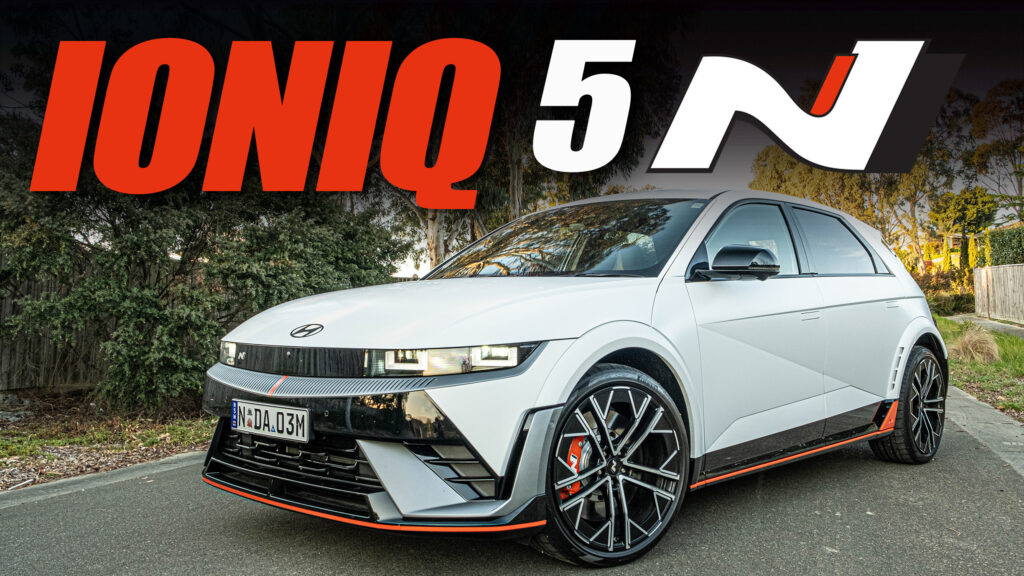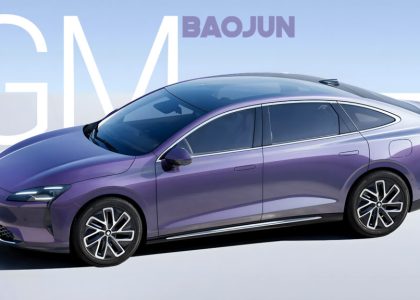
Remember when Hyundai was just that “nice but boring” carmaker your parents trusted for reliable grocery getters? Well, those days are officially dead and buried, now being quietly mocked in a corner by the Ioniq 5 N, a 601-horsepower slap in the face to the idea that electric cars are all glorified appliances. This EV doesn’t just exist; it barges into the room, shotgun in hand, and demands your attention.
It’s not just that the Ioniq 5 N is fast—although it’s stupid fast—it’s that it manages to cram a level of driving engagement into its hefty, practical frame that feels borderline illegal. On paper, it’s the kind of car that seems destined to make you question your loyalty to internal combustion. But promises on paper don’t always hold up in the real world, so we spent a week living with this modern muscle EV to find out if it’s truly the game-changer Hyundai claims, or just a flash in the pan with a fading battery.
QUICK FACTS
SWIPE
Photos Brad Anderson/Carscoops
We first drove the car during its Australian launch in February on several twisty roads and a racetrack and were blown away. However, it’s difficult to thoroughly test a car for just a few hours on the road and on a track. You have to actually live with it to understand it and accurately determine what’s good and what’s not so good about it. As such, we recently spent a week with the Ioniq 5 N to see how it deals with the rigors of everyday life and to discover if it is indeed the game-changing EV we thought it was after our initial test.
What makes it special?
The Ioniq 5 N is unlike anything else Hyundai’s N division has built before it. Prior to this car’s launch, N had only ever made hot hatches/sedans and a hotted-up version of the Kona crossover. All of its other cars produce between 201 hp and around 280 hp. So when it was revealed the company was launching a car with horsepower and performance to rival a Porsche Taycan, the world took notice.
More: 2025 Hyundai Ioniq 5 N Launched In Korea With Enhanced Drift Function And More Standard Kit
A key reason why the Ioniq 5 N is special is its powertrain. An 84 kWh battery pack is found beneath the skin and mated to two electric motors. A front-mounted motor delivers 235 hp (175 kW) and 370 Nm (273 lb-ft) of torque, while located at the rear is a punchier motor with 406 hp (303 kW) and 400 Nm (295 lb-ft). All up, the EV churns out 601 hp (448 kW). An extra 40 hp is unlocked when using the N Grin Boost function for 10-second bursts.

When jumping back behind the wheel of the car for the first time in more than 6 months, the immediacy and sheer power of the thing reminded me of just how exhilarating driving a high-powered electric car can be. If you’ve never experienced this feeling, do yourself a favor and try to arrange a test drive of a fast EV. Launching off the line in a car like this Hyundai feels akin to being on the world’s quickest rollercoaster, slamming your head back into the seat and making your face feel like Jell-O.
The carmaker says the Ioniq 5 N can hit 62 mph (100 km/h) in just 3.4 seconds, but we managed to record a best time of 3.1 seconds. That’s the same time we set with an Audi RS e-tron GT a few months ago and exemplifies the league of performance cars that the Ioniq 5 N can compete with.
Limited range but quick charging
Of course, performing successive launches in the 5 N quickly depletes the battery pack. Hyundai’s official claim is that the car can travel up to 448 km (278 miles) on a charge, but that’s almost impossible to achieve in the real world. Based on our experience, owners who drive their vehicles in urban environments, through city streets, and along highways, may get around 350 km (217 miles) if they’re having a little bit of fun on the way and tapping into the EV’s performance.
Photos Brad Anderson/Carscoops
While such a range figure isn’t terrible, it’s also not great. After all, the Ioniq 5 N is not a lightweight, two-door sports car that owners may use a few times a month. It is a big, practical family car that should be able to do everything a family car can, including long road trips, something it struggles with in Australia given the country’s woeful network of EV chargers. The limited range won’t be such a big deal in other markets, where 350 kW DC fast chargers are more readily available. Plugged in, it can be charged from 10-80% in just 18 minutes.
More: Hyundai Ioniq 5 N Is An Unlikely Rival To Audi’s RS7 Performance
During our time with the Ioniq 5 N, we were able to find a 350 kW charger and plugged it in for 25 minutes. In that time, the charger delivered 57.61 kWh of energy, which is about 68% of the pack’s total capacity. Charging speeds peaked at just shy of 240 kW, making this one of the quickest-charging EVs out there.
Superb handling, lots of modes to choose from
One of the most impressive things about the Ioniq 5 N is its handling. Despite weighing 2,230 kg (4,916 lbs), it hides its weight very well and loves nothing more than being hustled up a mountain road. The grip is absolutely tremendous and it’s very difficult to unsettle the car no matter how bad the road surface may be, a testament to the engineers who tuned the suspension.
Photos Brad Anderson/Carscoops
However, like other Hyundai N products, the adjustable suspension is best left in Normal mode as the Sport and Sport+ settings are too firm for the road. Similarly, the steering’s Normal mode is best and becomes too heavy in other modes. Some of the Ioniq 5 N’s dizzying array of driving modes and features are largely useless on the street. These include things like the N Drift Optimizer, N Torque Distribution that allows you to adjust the front and rear power bias, N Pedal, which maximizes brake regeneration, and N race modes.
Excluding these modes, there’s still plenty to play with. One of the Ioniq 5 N’s most recognizable features is N Active Sound+, which offers three different sound profiles. The first – and most interesting – is Ignition that aims to mimic the sound of Hyundai N’s combustion models. It does a good job of recreating the sound of an engine but does sound a little too much like you’re gaming on a PlayStation. One mode that’s hard to critique is N e-Shift, as it does a brilliant job of imitating an eight-speed dual-clutch.

One of the best things about all these modes is that they can easily be switched off, making the Ioniq 5 N feel quite docile and perfect for cruising around town. While the ride is firm even in its softest setting, the car feels right at home on suburban streets and is just as good at fetching groceries as it is embarrassing supercars from the traffic lights.
Hyundai has also equipped the Ioniq 5 N with Highway Driving Assist 2. This system includes adaptive cruise control with stop-and-go and lane-centering assistance like previous iterations of the tech suite but adds highway lane change assist. If you’re on a multi-lane highway with well-marked lines, all you have to do is flick on the turn signal, and the car will automatically change lanes for you. The system works well, although its usefulness is up for debate.
The tires don’t last
One of the key advantages of EVs is that they generally require less mechanical upkeep than combustion-powered cars. While that will probably also hold true for the Ioniq 5 N, this thing will chew through tires like you wouldn’t believe.
More: Hyundai Ioniq 5 N Sets New EV Records At Pikes Peak
As standard, it comes standard with specially-developed Pirelli P-Zero Corsa tires measuring 275/35 ZR21 at all four corners. These tires provide monumental levels of grip but have an almost unbelievably low treadwear rating of just 80. By comparison, typical Michelin Pilot Sport 4S tires have a treadwear rating of 300, and even competition-spec semi-slicks like the Toyo R888R have a 100 treadwear rating. It’s hardly a surprise then that our test car, with less than 7,000 km (~4,300 miles) on the odometer, only had about 1 mm of tread left.
Photos Brad Anderson/Carscoops
A spacious cabin, but with lots of hard plastics
The cabin of the Ioniq 5 N is good, just like the regular model. It’s a little bit of a shame Hyundai has ditched the sliding center console of the standard car in favor of a fixed unit and the fact the seats are manually-adjustable at this price point feels a little cheap. On the flip side, the front seats themselves are very comfortable over long journeys and also hold you in position well.
The 3,000 mm (118-inch) wheelbase means rear passengers have plenty of legroom, and a tilt function for the backrests is a nice feature. With a flat floor, it’s also possible to ferry three adults in the rear in relative comfort. Rear cargo space is only okay at 480 liters (16.9 cubic-feet) and is 80 liters (2.8 cubic-feet) less than the standard Ioniq 5. There’s also no frunk, as the N’s sound generator is located up front. There’s also too much hard, black, scratchy plastic found throughout. It’s fine on a regular car but isn’t so nice when you’re spending AU$120,000 (~$76,800).

Verdict
As is often the case, living with the Ioniq 5 N revealed a few minor foibles that we didn’t notice when first testing the car. Despite these imperfections, though, it’s still an absolute animal that provides great driving thrills, proving that EVs don’t have to be boring.
As a technical exercise, it’s remarkable and will likely remain the driver-focused EV benchmark in its segment until someone comes up with something even better. But we wouldn’t buy one. We’d rather get an i30 N Sedan and pocket the extra AU$60,000 (~$38,400).





